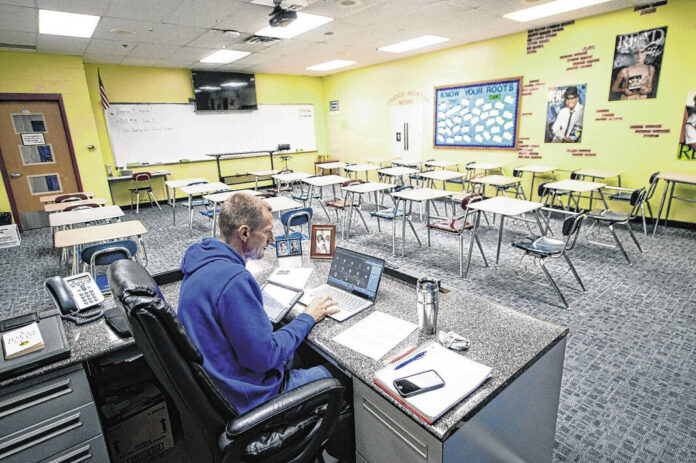
Sitting alone in his empty classroom, Greenfield-Central High School English teacher Mike Foster works with his students by computer during a virtual class in April 2021. The state of Indiana just passed a law outlining requirements for virtual instruction.
Daily Reporter file photo
HANCOCK COUNTY — Schools are studying up on a new state law setting requirements for a practice they’ve grown more and more familiar with over the past couple years — virtual learning.
The bill, authored by Robert Behning, R-Indianapolis, addresses multiple education matters, including two kinds of virtual instruction: synchronous and asynchronous.
Synchronous instruction consists of a teacher using a computer or similar device to teach a class with students viewing and participating via devices remotely.
During asynchronous instruction, students take part by themselves in schoolwork their teachers make available to them online.
Gov. Eric Holcomb signed the bill into law earlier this month. The legislation states that during a virtual school day, schools must deliver teacher-directed synchronous instruction for at least half of the instructional day, and the other half can be asynchronous learning.
Schools may, however, conduct up to three virtual instructional days each school year that don’t meet those requirements. Anything over that may not count toward meeting a total 180-day school year.
The law also allows schools to request a waiver from the Indiana Department of Education to include a virtual day outside of the requirements if conducted “because of extraordinary circumstances.”
Wes Anderson, director of school and community relations for the Community School Corporation of Southern Hancock County, said the law will affect how the corporation does teacher development days. Southern Hancock typically sets aside four days every school year for teacher development. Because teachers are busy with that on those days and can’t teach, schools provide asynchronous virtual instruction.
The corporation has used asynchronous instruction on snow days too, Anderson added.
“We, one, have to figure out how we’re going to do teacher development going forward — what that’s going to look like,” he said. “And then the other question is going to be what we’re going to do on those snow days. Are we OK having those as virtual days, where the kids have to be tethered to their devices for some portion of the school day, or are those going to be where we’re just going to close and make it up at the end of the year?”
Anderson said Southern Hancock educators are well versed in synchronous instruction, especially after school closures throughout the COVID-19 pandemic.
The synchronous instruction requirements also raise concerns over students without internet service at home, he said. He recalled how the school corporation made efforts to help with that during the pandemic by boosting internet into schools’ parking lots for students to access in vehicles, and by parking school buses throughout the community with WiFi adapters.
“Obviously that’s not going to work if there’s a foot of snow on the ground,” Anderson said.
Harold Olin, superintendent of Greenfield-Central Schools, said teachers and students there have also adapted well when synchronous instruction has been called for.
“We have tried to use synchronous learning for most of our eLearning days,” Olin said, adding it’s especially prevalent when students in kindergarten through eighth grade are doing virtual learning.
Similar to Southern Hancock, G-C does asynchronous instruction on its professional development days as well, which add up to two to three a year. During those, teachers engage in professional development for half the day and are available the second half to follow up with students and answer any questions they have about assignments.
“It’s something we had our eye on, but we’re not overly concerned with it,” Olin said of the new law. “We do believe the synchronous opportunities are best for our students anyway.”
George Philhower, superintendent of the Community School Corporation of Eastern Hancock County, said he and his colleagues are still determining what the recent rules will mean for the district. He added the corporation has a couple eLearning days built into its 2022-23 school year calendar.
As with many schools operating under a pandemic, Eastern Hancock is no stranger to synchronous learning either.
“I think we got better at it in the older grades,” Philhower said. “I got a first-grader that lives with me at home. Getting him tuned in to live instruction isn’t the most easy thing to do, so I’m pretty sympathetic to our families with younger kids. We will continue to try to be as family-friendly with that as we can.”
State legislators representing Hancock County supported the law in its early stages as it made its way through both chambers of the Indiana General Assembly.
“It really was intended to try to put some sideboards on the number of days that the schools can use as eLearning days,” said State Sen. Michael Crider, R-Greenfield. “There’s still a waiver process they can go through with the department of education to get more days (outside of the requirements) if needed.”
Crider said he spoke with constituents working in school systems in his district who indicated they preferred more than three virtual days allowed outside of the rule requiring half synchronous instruction.
“I would’ve preferred what the schools suggested,” he said. “I don’t always win. I passed along their concerns, but it didn’t get incorporated into the final version.”
State Rep. Bob Cherry, R-Greenfield, said he would’ve preferred the requirement regarding synchronous instruction to be more than half of a day.
“I think it ought to be 75%,” he said. “Over half our state budget goes to education, and we are losing a lot of education outcomes because of what happened with COVID. We want our kids to not fall behind.”




